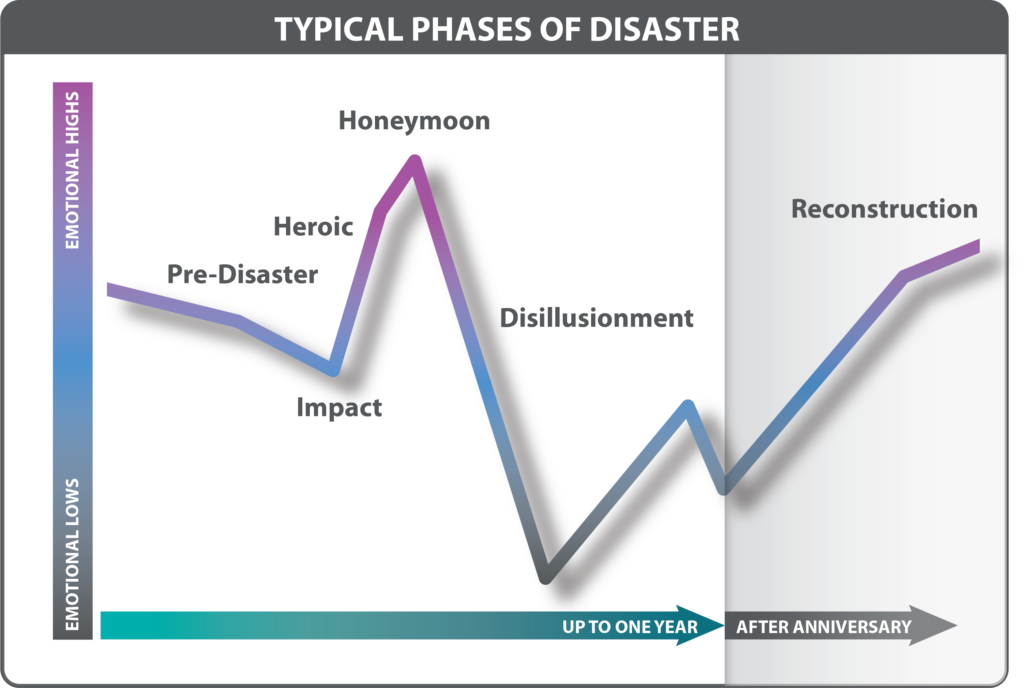6 Tips To Manage Schools Through A Disaster

INTRO
School administrators are coping with fires, storms, and floods on top of the deep disruption from COVID-19. Here are advice and resources from educators Tim Taylor (Executive Director, SSDA), Casey Taylor (Executive Director, Achieve Center), and Mike Walsh (Director-at-Large, CCBE) on how to manage a school community following a disaster based on their experience from the 2018 Camp Fire in Paradise, CA.
OBJECTIVES
- Understand the primary role of schools in a community following a disaster
- Learn what school leaders should focus on in the aftermath of disaster
While it’s nothing new for schools to face challenges, lately, it seems those challenges are becoming even more colossal and commonplace. School leaders forced to confront natural disasters, tragedies, and now a pandemic often find themselves scrambling to provide support for their community and facing confusion about their roles in the recovery process.
Earlier this fall, after wildfires devastated several Oregon communities, we talked with educators Tim Taylor (Executive Director, Small School Districts’ Association), Casey Taylor (Executive Director, Achieve Center), and Mike Walsh (Director-at-Large, California County Boards of Education) about how to manage a school community following a disaster based on their experiences during and after the 2018 Camp Fire in Paradise, CA. These three leaders shared their own wisdom and advice with several superintendents from Oregon school districts impacted by the wildfires. In the first part of the conversation, they discussed what they see as the three primary roles of schools and what school leaders should focus on in the aftermath of disaster.

Locate students and staff and make sure they’re safe
Put all resources into locating everyone in your community and making sure they are safe before starting to gather donations or coordinating other relief efforts. Evacuations during disasters like wildfires, earthquakes, or tornadoes cause people to scatter far and wide. You can’t communicate with or support people if you can’t find them. Plan on not getting much sleep while you carry out this task.

Help with immediate needs
Once you’ve located everyone, the focus shifts to coordinating ways to meet the physical needs of your community. Families may have left their homes in the middle of the night with nothing but the clothes on their backs. Find out what their biggest needs are and set up your school as a hub for relief. Set up donation channels. Connect families with resources. Help them navigate through social services. Provide access to childcare. Look for creative ways to meet their needs.

Provide a vision of how to get back to school
Your primary goal is to get everyone back to school and establish a sense of normalcy. Communicate a hope and vision without sugarcoating the current situation. Acknowledge the difficulty and provide encouragement that by working together the community will recover. Clearly convey where things stand and the plan for recovery on a regular basis to keep everyone in the loop.
Advice From The Experienced
Recovery from trauma is difficult, but overcoming it in a healthy way often results in a community that bonds deeply and comes back stronger than before. Watch the video below to hear from the Paradise school leaders as they talk with two school districts currently navigating the aftermath of the wildfires in Oregon.
Once school leaders are through the immediate aftermath of a traumatic event, there is a multi-year-long recovery process that follows. The educators from Paradise, California shared what recovery and reconstruction look like as communities deal with safety, trauma, and slowly rebuilding after a major disaster.
Supporting Students Who Have Experienced Trauma
Based on the experiences of school leaders who have had to guide their communities in challenging times, the strategies below offer insight on how to manage schools through a disaster.
6 TIPS TO MANAGE SCHOOLS THROUGH A DISASTER

PRIORITIZE CARING FOR YOURSELF AND YOUR STAFF
Support traumatized teachers by hiring a full-time substitute to assist
Provide signing bonuses to every staff member who agrees to stay for the next school year
Give yourself permission to feel what’s going on

REQUEST AND ACCEPT HELP
Bring in help from outside your district, like firefighting teams do
Find a trustworthy coordinator to manage donations
Form a full mental health team: coordinator, crisis counselor, trauma counselor, school psychologist
Hire interim principals to share the work of getting schools back up and running
Ask your school district attorney how they can help
Hire a budget coordinator to manage purchases and pay bills for replacement items

BE STRATEGIC ABOUT COMMUNICATIONS
FOR THE COMMUNITY
Make sure your students and staff are safe and communicate that regularly
Only say what is confirmed by official fire, law enforcement, and emergency sources
Do a daily community update
WITH SCHOOL BOARD MEMBERS
Make sure they know where to see your daily updates
Longer term, have them help you tell your story
Ask them to focus on legislation for long-term aid for your schools
TO NEWS OUTLETS
Be prepared to deal with the national media
Tell your story to help get long-term donations
Update school websites with photos of the damage and ask for donations
WITH OTHERS
Ask legislators for help with existing school bonds that are linked to property taxes and fund schools
Stay in regular contact with unions about financial support for staff and plans for the future

STREAMLINE DECISION MAKING
Set up daily updates for school board members and ask them not to call school leaders unless absolutely necessary
Determine what school board resolutions need to be passed to make sure leaders have temporary authority to make all necessary decisions
Ask the board to focus on long-term issues: FEMA contracts, facility contracts, enrollment funding waivers

ACCESS AND LEVERAGE ALL RELIEF MONEY
Designate a FEMA coordinator to identify needs, fill out forms, and chase funds
Use FEMA funds for people to help run schools or manage your district, not just for structures or supplies
Make full use of funding from the McKinney-Vento Homeless Assistance Act for students
Access free meals and shelter benefits via the USDA’s child nutrition program

PREPARE FOR THE HIGHS AND LOWS
Recovery and Restore phase: For the first year, everyone in the community is in various degrees of trauma. This could last up to two years with peaks and crashes
Reconstruction phase: Expect ten years, with new construction starting after nine or ten months

Disaster Recovery in Rural Oregon
For more ideas read the stories of how Oregon school districts in Santiam Canyon and Vernonia overcame disasters.
Santiam Canyon’s Story
Vernonia’s Story
Stay in the Loop
Subscribe to Our Newsletter
This work by Inflexion is licensed under Creative Commons Attribution-NonCommercial-ShareAlike 4.0 International







Responses